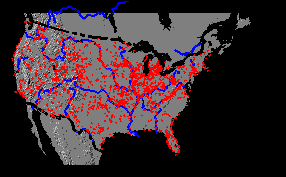
FAUNMAP: An electronic database documenting late Quaternary distributions of mammal species
FAUNMAP is an electronic database documenting the late Quaternary distribution of mammal species in the United States. It has been developed at the Illinois State Museum (ISM) with support from the National Science Foundation (BSR-9005144). This project is co-directed by Drs. Russell W. Graham formally of ISM and now at the Denver Museum of Natural History, and Ernest L. Lundelius, Jr. from the University of Texas at Austin. The primary purpose of this database is to investigate the evolution of mammalian communities. Specifically, with statistical techniques and mapping capabilities of a Geographic Information System (GIS), changes in the distributions of individual species and their effects upon mammal community composition can be documented for the late Quaternary. Understanding these processes will also facilitate paleoenvironmental reconstructions.For the past four years, data have been captured from paleontological and archaeological sites that contain mammalian remains. There are currently encoded data from 2919 sites. FAUNMAP focuses on sites in the contiguous 48 states during the last 40,000 years, i.e., 40 ka, or essentially the limits of radiocarbon dating.
Disribution of Faunmap sitesYou may also download a larger and clearer (about 70 kb) distribution map of Faunmap sites.
Selection criteria for incorporation ofsites into the database include the following:
A network of 14 regional collaborators from throughout the United States andCanada assisted with data selection and validation.
- know geographic location (at least county level);
- chronologic controls (stratigraphic, biostratigraphic, cultural affiliation, radiometric dates); and
- voucher specimens (actual specimen, cast or photograph) in a public institution.
Data were derived from the scientific literature, including selected theses and contract reports. Information on site names and numbers, location, relative and absolute chronologies, including cultural associations, depositional systems, taphonomic attributes, and mammal species from each site was recorded. The structure of the database allows for differentiation of the smallest component of a site, e.g., microstratigraphy, cultural component, etc., as defined by the original author. This information is then linked with an electronic bibliography documenting data sources.
Data were entered electronically on IBM compatible PC computers with a commercial relational database software, PARADOX. This approach has several advantages. By using PCs, the GIS workstation was not tied up with data entry. By having the database on a PC platform with a commercially available database manager, it is easy to distribute the database to anyone with this or a similarly compatible system. In other words, one does not need a sophisiticated GIS workstation to use the attribute files of the database. However, if your browser is capable of forms, you may query the database, including online distribution maps.
Data files can be sorted in a relational environment selecting for any combination of attributes desired, e.g., one species from a certain age range and specific site type. This information was then transported via ETHERNET to an IBM RS6000 GIS workstation in orderto generate time series maps of changing distributions through time. By using latitude and longitude as the site locators, the database can be manipulated on any GIS system. ARC/INFO is used at the ISM.
The real power of a GIS as an interdisciplinary tool is its ability to easily overlay maps of different types. For FAUNMAP, maps of modern mammal species distributions and Laurentide Ice Sheet boundaries have been digitized with ARC/INFO and can be overlain on the paleontological and archeological site maps for different species at various time intervals. Likewise, the FAUNMAP database can be overlain on other types of maps, e.g., paleovegetation or paleolandscape. Some posters have been produced based on the Faunmap data demonstrating these uses.
We have also used FAUNMAP data in our online exhibit of The Midwestern U.S. 16,000 Years Ago and Pleistocene Animals.
- Faunmap is available in hardcopy and on disc
- You may download the Faunmap database/
- You may query the database
| ISM Home | | General Information | | Programs | | Events | | Exhibits | | Collections | | Sites | | Membership |
© Illinois State Museum Society-- Last updated 21-Mar-96 by Erich Schroeder
